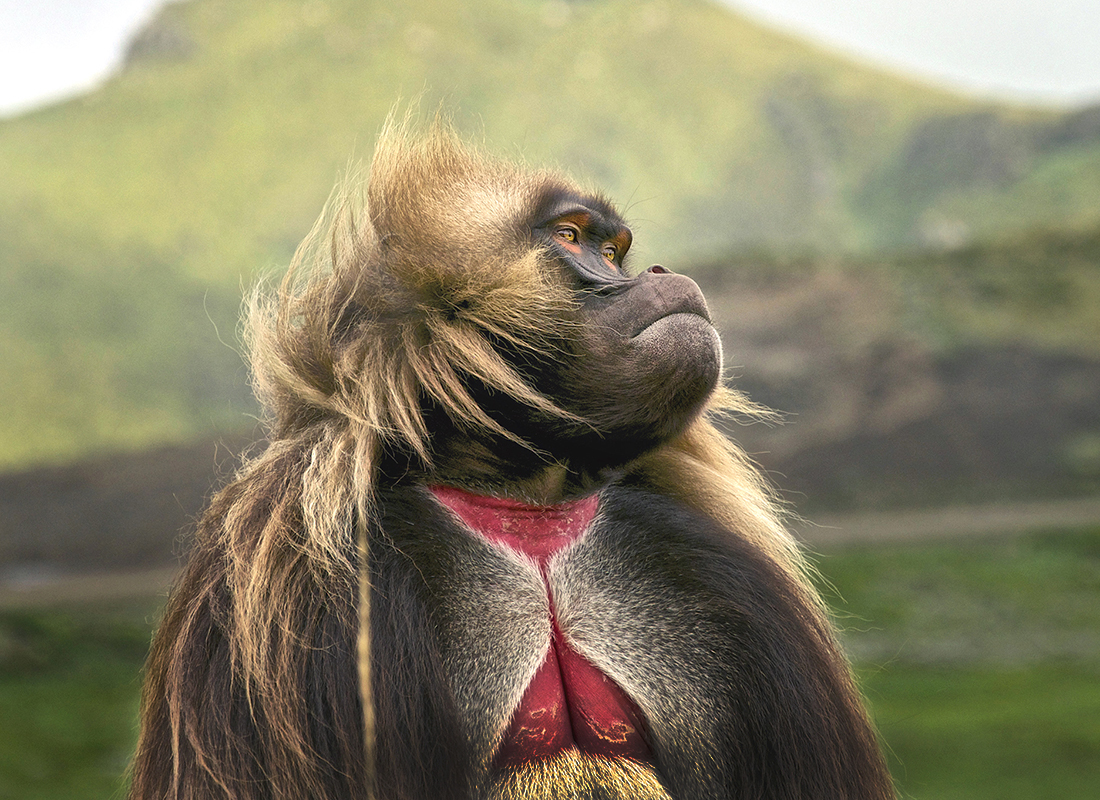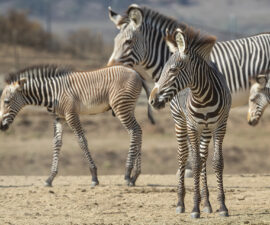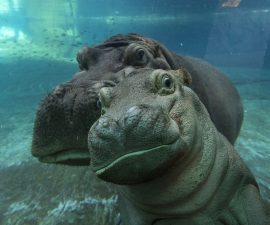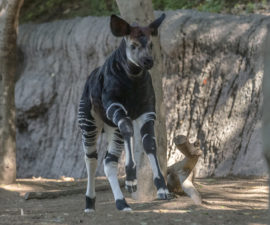BY Donna Parham
Photography by Ken Bohn
The most striking feature of a gelada Theropithecus gelada is a hairless, pink or red, hourglass-shaped patch of skin on its chest. But chances are, you’ve never been this close to a gelada—if you’ve seen one at all. The gelada habitat in the heart of Conrad Prebys Africa Rocks is one of only two exhibits for these unusual primates in all of North America. “They are truly a unique, majestic species of monkey,” says Dean Gibson, curator of primates, who was integral in bringing the handsome, long-haired monkeys to the San Diego Zoo.
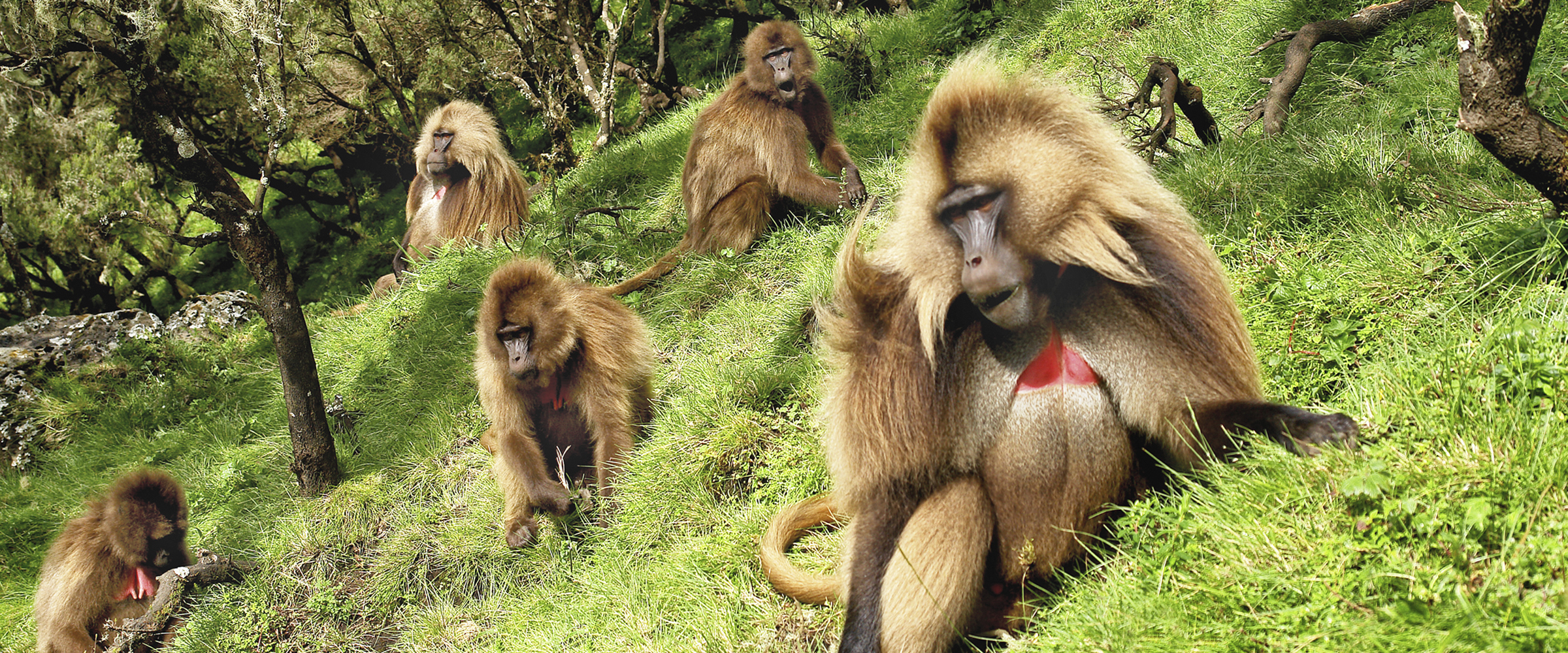
AT HOME IN THE HIGHLANDS
Endemic to the Ethiopian Highlands, the gelada is the only surviving species in the Theropithecus lineage, which once lived throughout many parts of Africa and even into India. Geladas inhabit the rugged mountains and open plateaus known as the Roof of Africa—14,000 feet above sea level. While most other monkeys hang out in trees, geladas rarely leave the ground, spending their days foraging in windswept, alpine grasslands.
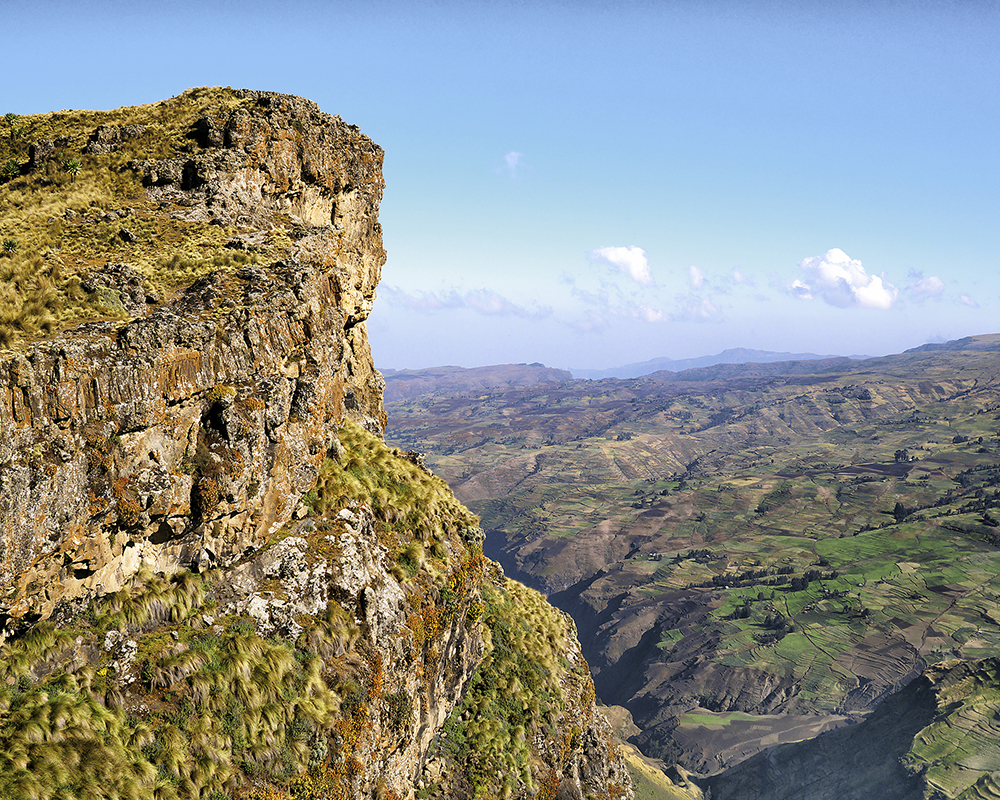
HOME, SWEET HOME
Geladas inhabit windswept plateaus punctuated by steep cliffs, such as this habitat in Ethiopia’s Simien National Park. (Photo by: Ondrej111/iStock/Getty Images Plus; (Previous) RobNaw/iStock/Getty Images Plus; (Top) Jeffrey T. Kerby)
They are the only grass-eating monkeys in the world, plucking long grass blades with their dexterous, if stubby, forefingers and highly opposable thumbs. During the dry season, grass is less plentiful, so geladas supplement their diet with other low-growing plants, and even use their strong fingers to dig for subterranean rhizomes and tubers. When the occasion presents itself, they’ll gobble insects, snails, and fruit, too.
As evening approaches, geladas scramble partway down sheer cliff faces for a peaceful night’s sleep on precarious, craggy ledges—safe from less sure-footed predators—until the sun comes up. “Their super-strong, stubby fingers can reach into the tiniest cracks in cliffs,” says Dean. “That makes them excellent climbers.”
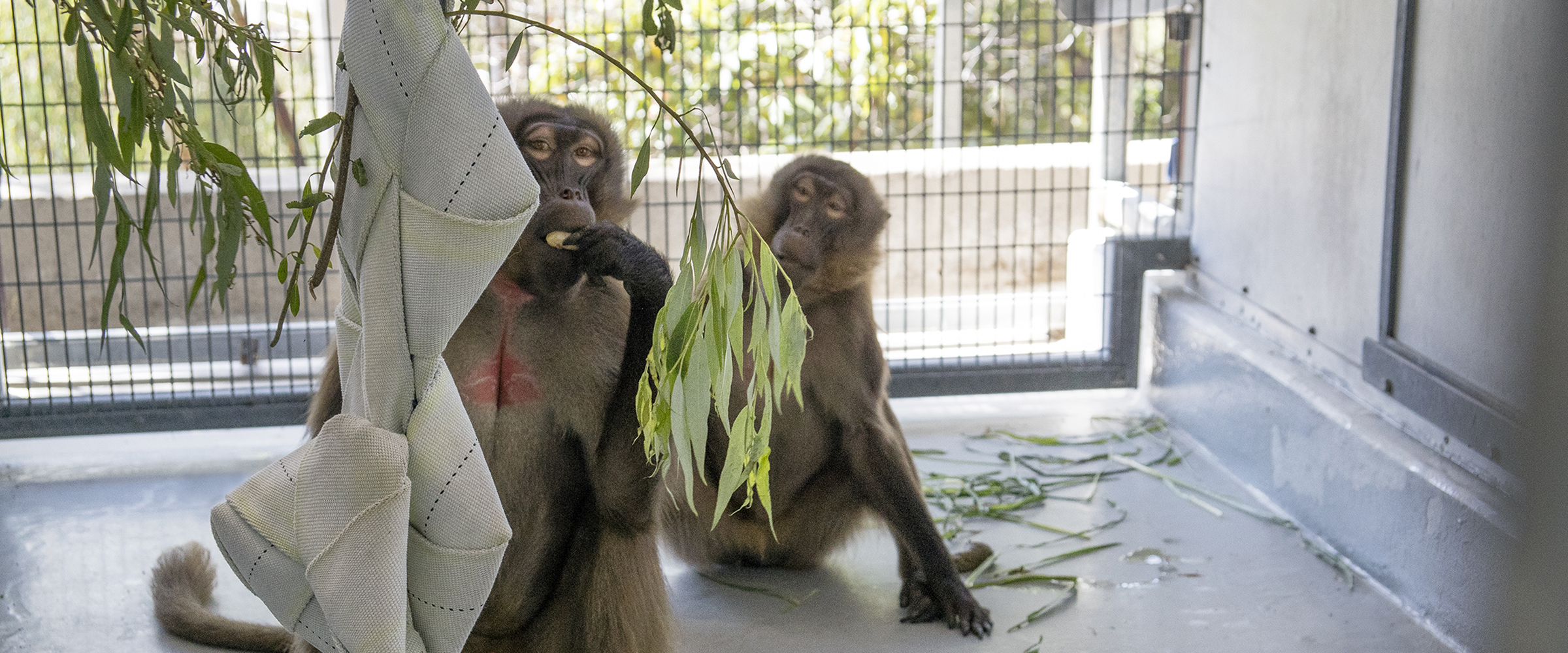
COMING TO AMERICA
“For a long time, geladas have not been available to American zoos,” says Dean. But, before the Africa Rocks project broke ground, she met the coordinator of the European Endangered Species Programme (EEP) for geladas—the European equivalent of an Association of Zoos and Aquariums’ (AZA) Species Survival Plan (SSP) program—which led to her attending the next annual EEP gelada meeting.
“Geladas have been thriving and reproducing in European zoos,” says Dean. At home, we were getting ready to build a new hamadryas baboon habitat—a habitat that happens to be also especially well suited for geladas. Dean offered some of that space to help the European Association of Zoos and Aquariums (EAZA) expand their gelada EEP breeding program, and EAZA agreed to send a group of geladas to San Diego. “The Bronx Zoo already has geladas, so we aren’t the only ones in North America, and we will be working closely with our counterparts at the Bronx Zoo,” says Dean.
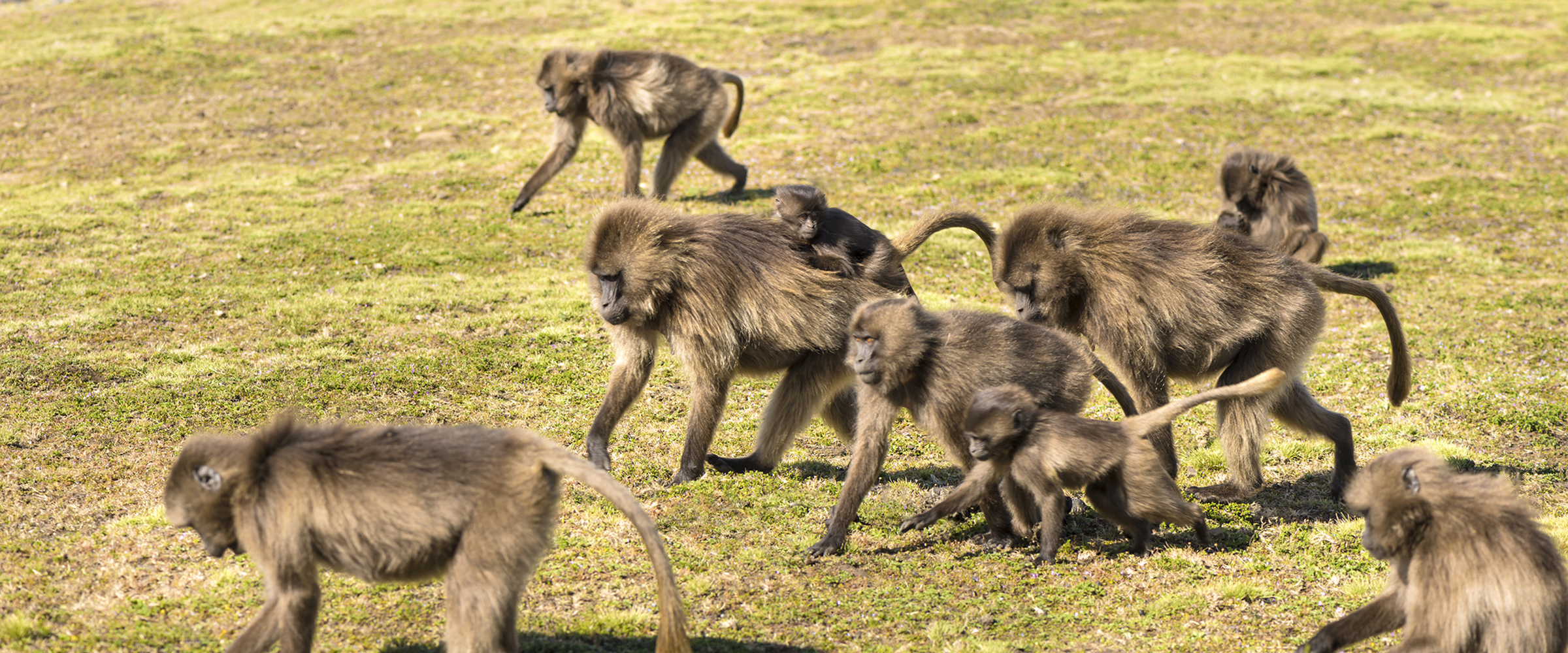
BOY BAND
Geladas live in social groups known as one-male units (OMUs): a single adult male, several females, and their offspring. OMUs join to form larger foraging bands. While females spend their lives in the same OMU, young males leave their group as they approach adulthood, typically spending a few years in an all-male unit before joining an OMU by overthrowing an existing male leader. The geladas of Africa Rocks—six young males—came to us from a large group at the Wilhelma Zoo in Stuttgart, Germany. We plan to add females to the group some time in the future.
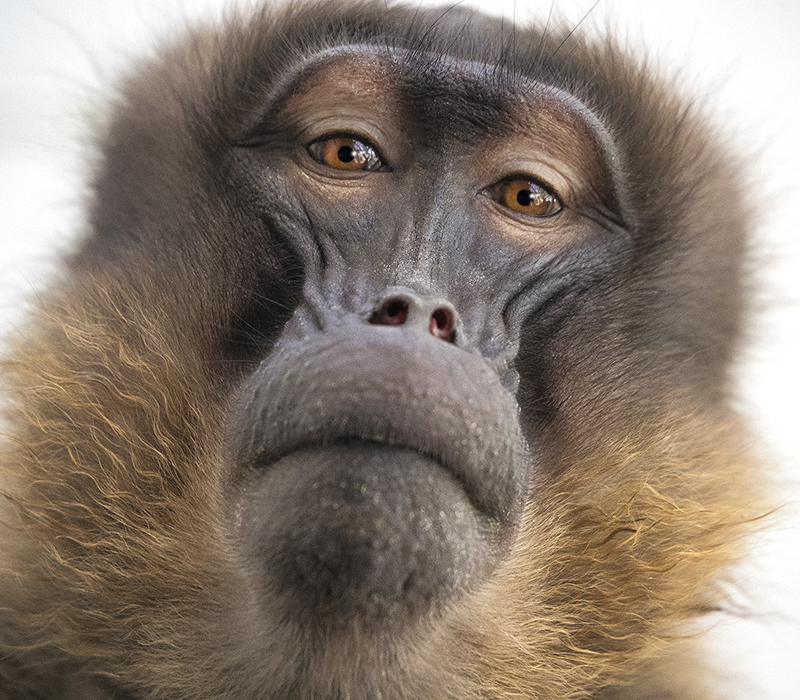
YOUNGSTERS
The young geladas are just starting to develop what will ultimately be the flowing manes typical of adult males. (Previous photo by: helovi/iStock/Getty Images Plus)
After much anticipation, the all-male unit arrived September 7, 2016. Keeper Sandy Distatte has spent a lot of time observing and getting to know the six geladas: Mahbub, Saburi, Abasi, Diwani, Valentino, and Juma. She describes Mahbub as the most even-tempered, mellow monkey of the group. She says that confident Saburi has proven to be the most independent. “If something is slightly different in the area they’re entering, he will typically lead the way. He’s also progressed the quickest in their training program, which promotes voluntary participation in their care.”
Saburi’s closest buddy, Abasi, keeps Sandy on her toes. “I noticed right away that he can be an instigator,” she says, with a chuckle. Abasi sometimes asserts his power over Diwani, the youngest. When he does, Valentino often acts as peacemaker, breaking up squabbles between the two. Valentino is Juma’s “right-hand man,” according to Sandy, and Juma is “top dog.” “When they first arrived, the other boys wouldn’t even approach me if Juma was around,” says Sandy, who quickly adjusted her training program to accommodate the group’s existing dominance hierarchy.
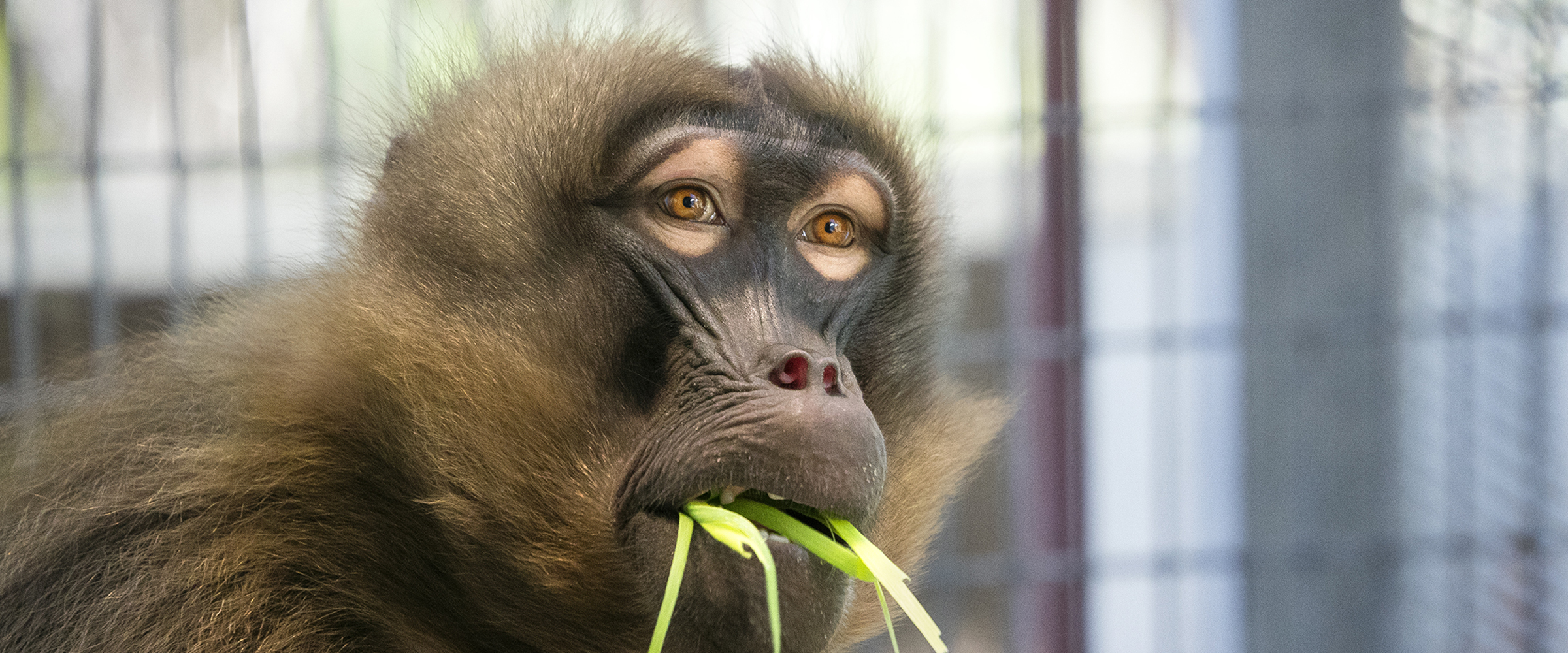
GETTING READY TO ROCK
“My first priority has been getting them ready for Africa Rocks,” says Sandy, who set about training the geladas the husbandry behaviors that allow us to take the best possible care of them. Because they lived with a group of 44 geladas before coming to San Diego, “They had never been exposed to positive reinforcement training that gives them the opportunity to voluntarily participate in their own daily and medical care,” says Sandy. “So, my first priority was actually building my relationship with them and gaining their trust through our daily interaction.” Now, each of the geladas has his own station marker; the six markers are different colors and shapes. The ability to have them station allows keepers to work with them individually without having to separate them, to accommodate health and husbandry procedures. Perhaps predictably, Juma was one of the first to consistently station at the right place. The geladas have also learned to enter a chute (which has a built-in scale), touch a target, enter a rolling crate, and recognize the sound of a clicker—something that’s used as a “yes” signal when training.
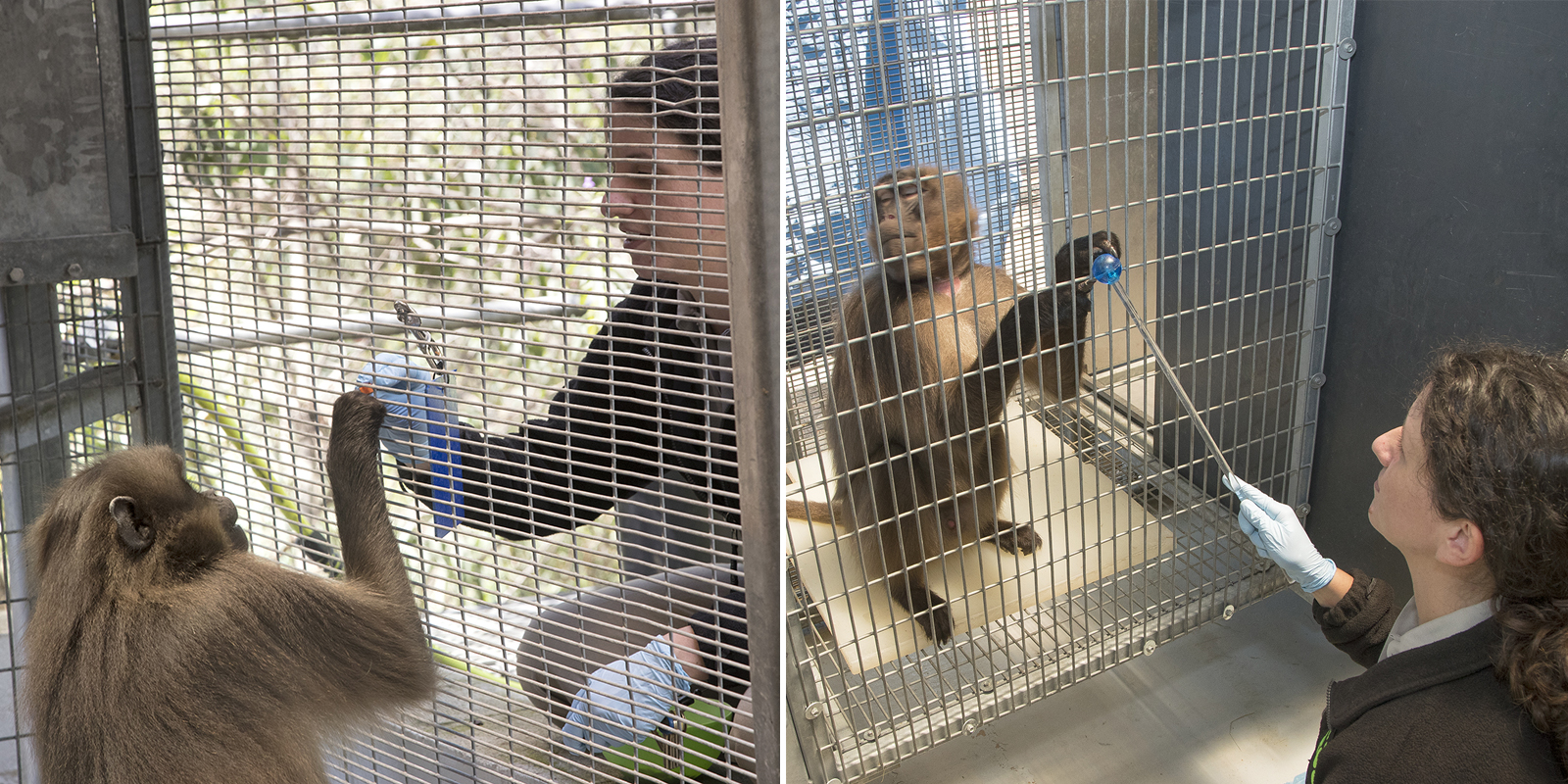
READY AND WILLING
Juma’s station marker is a blue rectangle. Sandy rewards him when he stations, when he enters a chute, and when he touches a target. Such behaviors give the geladas the opportunity to voluntarily participate in their own care.
Each morning, the geladas will be called into their bedrooms so that keepers can clean and maintain their Africa Rocks exhibit space before the Zoo opens. The ring of a bell tells the monkeys when it’s time to come inside. Sandy taught the geladas to respond to the bell by ringing it when it’s time to receive their prepared diet—something they relish. “I had to ring it softly at first, because they hadn’t heard a bell before, and it could have startled them,” she says. “But they caught on quickly.”
Up to 90 percent of the geladas’ diet consists of grass, so Sandy feeds the geladas napier grass, bermuda hay, low-starch biscuits, greens, other veggies, and fruits. Hydroponically grown grass is occasionally offered as enrichment. “When the grass has seeds,” she says, “they really enjoy it—they eat the seeds first,” likely something their counterparts in the wild do also.
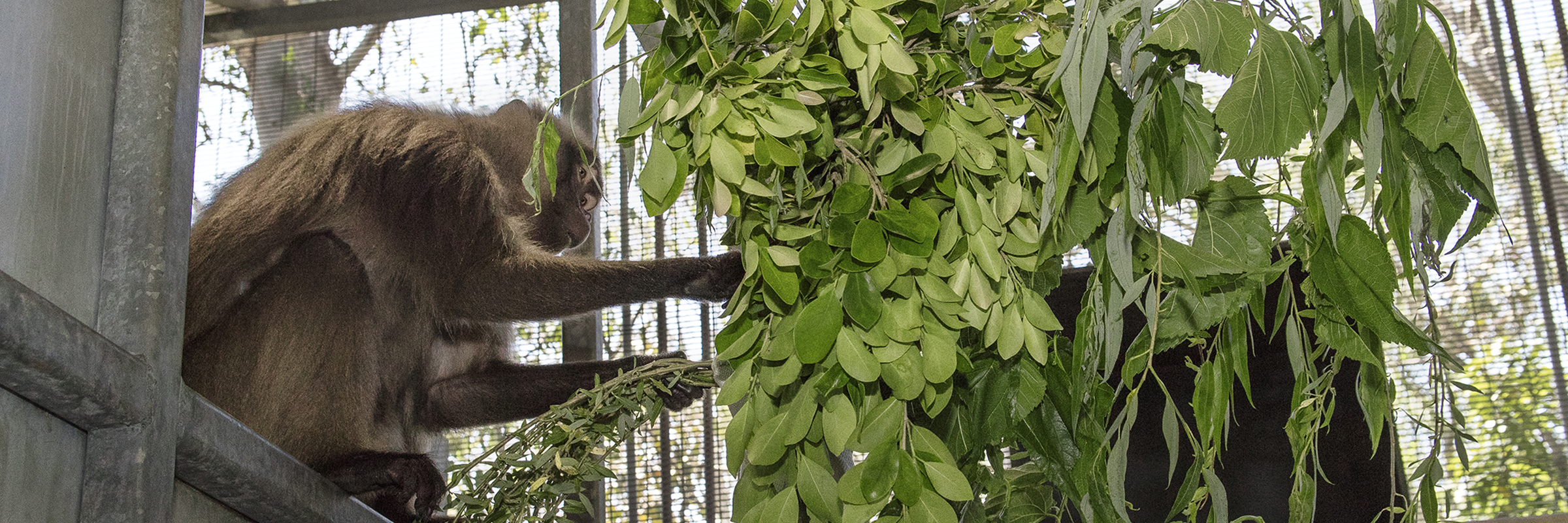
MONKEYING AROUND
The gelada habitat in Africa Rocks is designed with grassy plateaus atop high bluffs. “Visitors will be able to see the daily pattern of geladas’ migration up and down the cliffs,” says Dean. Water features will provide the opportunity for geladas to cool off, and scatter feeders will offer enrichment.
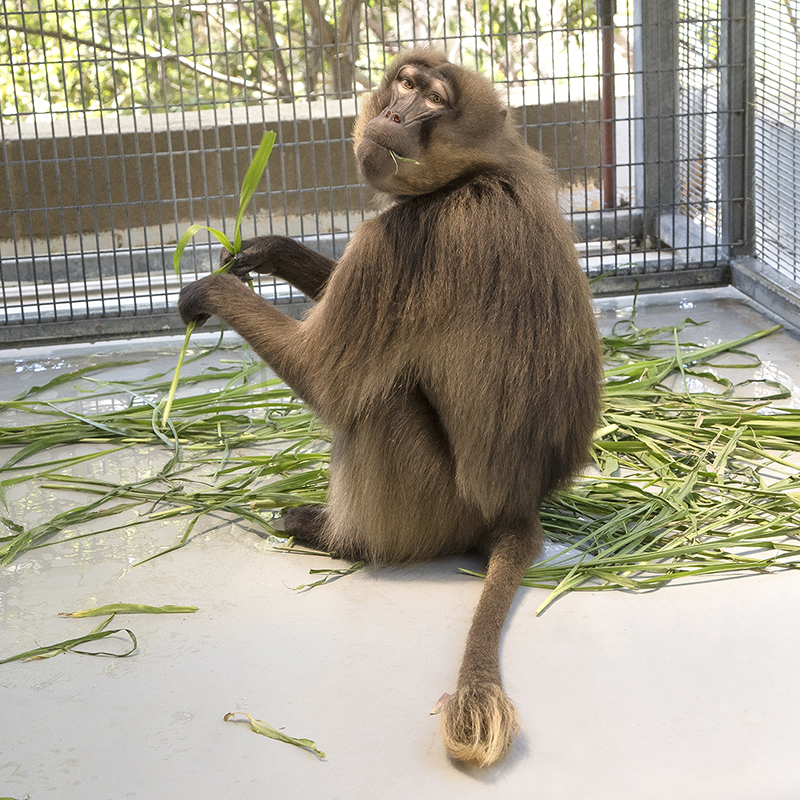
GRAMNIVORE
Geladas are the only grass-eating monkeys in the world.
Visitors will delight in observing the large monkeys enjoying grass, playing, and interacting with the Nubian ibex that share their habitat. Also enchanting are the expressive faces of the geladas. One facial gesture unique to geladas is the lip flip: a gelada flips its entire upper lip over its nose, exposing its formidable canine teeth and an expanse of gums. “The lip flip by itself is a friendly greeting,” says Dean. But when a gelada lifts its brow to show its pale eyelids while lip-flipping, that’s a different story. “In combination, that’s a threat,” she confirms.
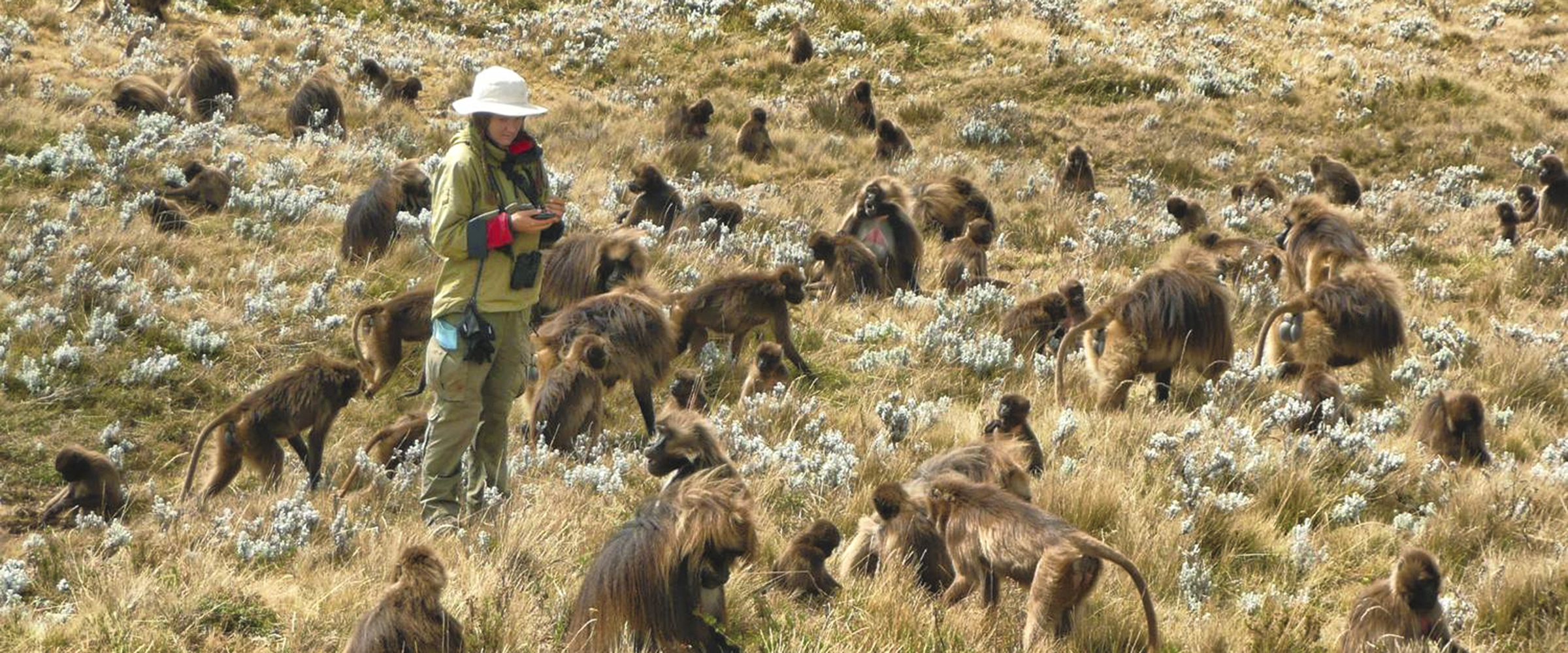
FIGHTING EXTINCTION
The people who just might know the most about geladas are researchers Peter Fashing, Ph.D. and Nga Nguyen, Ph.D., who head up the Guassa Gelada Project, research that San Diego Zoo Global has supported since 2012. They study the geladas of Guassa—a 43-square-mile area of Ethiopia that is the largest remaining expanse of naturalistic gelada habitat in the world. Over the years, they and their research associates and students have observed individually recognized animals and have recorded births, deaths, immigrations, emigrations, and behavior.
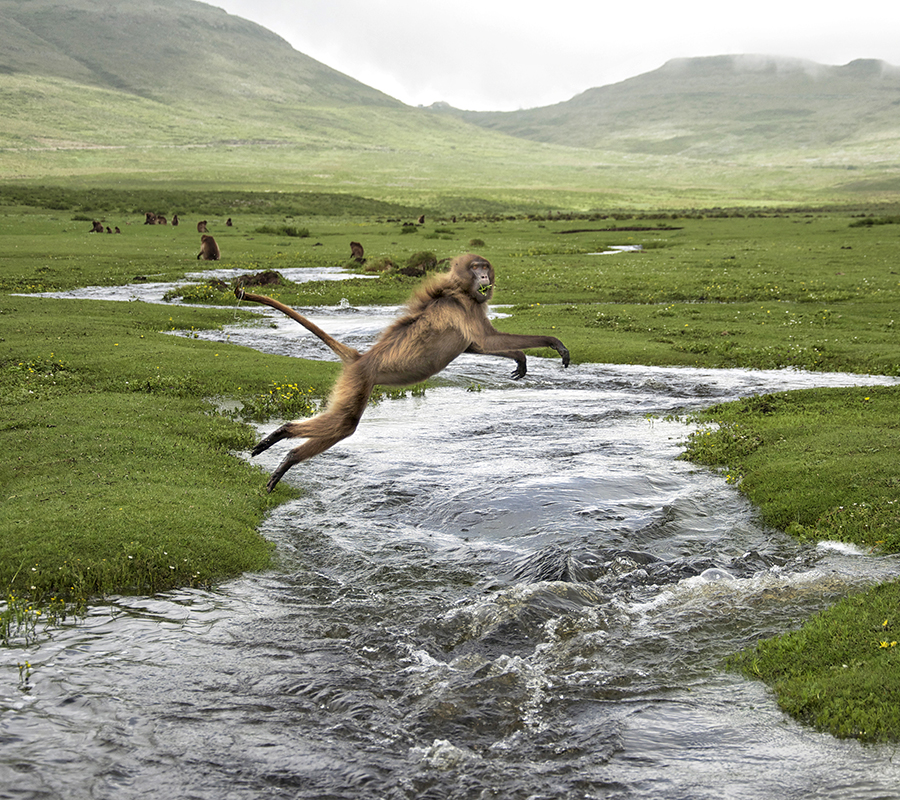
THE GRASS IS ALWAYS GREENER
A gelada leaps agilely over a stream in the Ethiopian Highlands. Unlike most other monkeys, geladas spend most of their time on the ground. (Photo by: Jeffrey T. Kerby; (Previous): Niina Nurmi)
The team currently is working on an assessment of gelada abundance across their entire range, which is shrinking due to human population growth. With the study only three-fourths completed, researchers found that in about 80 percent of the sites they have surveyed so far, habitat had been compromised—with the encroachment of humans, croplands, rangelands, and domestic livestock.
The research team expects to complete their population assessment and analysis later this year. The larger goal is to reassess the IUCN status of geladas, and petition for a status change if the results bear out their preliminary findings. Last assessed in 2008, the existing IUCN Red List designations—Least Concern for the southern subspecies and Vulnerable for the northern subspecies—are “almost certainly erroneous,” according to the researchers.
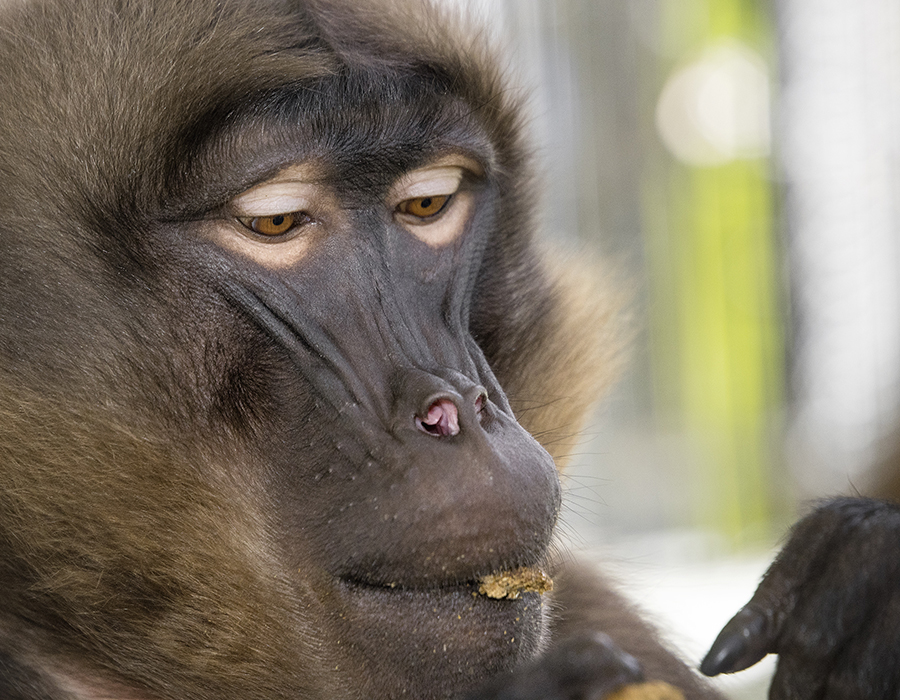
LOCAL PRESENCE
The San Diego Zoo will be one of only two places in all of North America where people can see these unusual primates.
There’s no doubt that this distinctive primate is in trouble. Dean and her colleagues are hoping that displaying the unique monkeys at the Zoo helps raise awareness of their plight. “With geladas, we are looking at a potential extinction event,” says Carmi Penny, director of Collections Husbandry Science at the Zoo. But as San Diego Zoo Global leads the fight against extinction, we’re doing our best to keep time from running out for the hourglass monkey.

